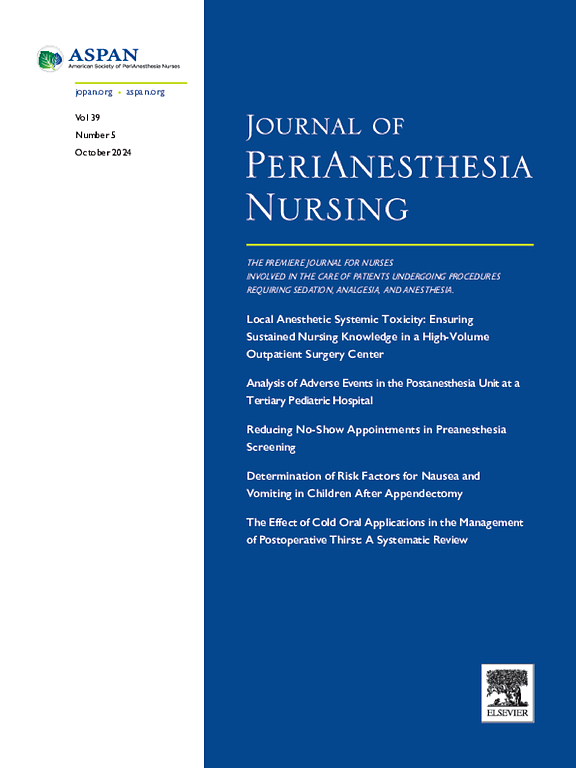穴位按摩对耳鼻喉科患者术前焦虑、术后疼痛以及恶心呕吐的影响
IF 1.6
4区 医学
Q2 NURSING
引用次数: 0
摘要
目的:手术患者经常会出现术前焦虑、术后疼痛、恶心呕吐等症状。本研究旨在确定穴位按摩对耳鼻喉科患者术前焦虑、术后疼痛和恶心呕吐的影响:研究设计为前瞻性、评估者盲法、平行、双臂(1:1)、随机对照试验:研究样本包括 60 名耳鼻喉科患者。患者被随机分配到穴位按摩组(30 人)或对照组(30 人)(1:1)。在术前期间,穴位按摩组的参与者接受了 15 分钟的治疗,对 HT7、LI4 和 EX-HN3 穴位进行按压。对照组参与者未接受任何干预。在进行穴位按摩之前和之后 15 分钟,使用国家焦虑量表对术前焦虑水平进行评估。术后 4 小时、晚上 10:00、早上 8:00 和出院时,使用数字疼痛评分量表对术后疼痛进行评估。出院时使用罗德恶心、呕吐和反胃指数评估术后恶心和呕吐情况:尽管对照组患者在手术室等候区的术前焦虑程度有所上升,但穴位按摩组患者的焦虑程度明显下降(P = .033)。两组患者在术后第四小时和晚上 10:00 时的术后疼痛严重程度相似(P > .05),而穴位按摩组在早上 8:00 时(P = .04)和出院时(P = .048)的疼痛严重程度明显降低。两组在术后恶心和呕吐症状方面无明显差异(P > .05):结论:穴位按摩能有效减轻耳鼻喉科患者术前焦虑和术后疼痛的严重程度,但在术后恶心和呕吐方面没有观察到同样的效果。本文章由计算机程序翻译,如有差异,请以英文原文为准。
The Effects of Acupressure on Preoperative Anxiety, Postoperative Pain, and Nausea and Vomiting in Otolaryngology Patients
Purpose
Surgical patients frequently experience symptoms such as preoperative anxiety, postoperative pain, and nausea and vomiting. The aim of this study was to determine the effects of acupressure on preoperative anxiety, postoperative pain, and nausea and vomiting in otolaryngology patients.
Design
The study was designed as a prospective, assessor-blinded, parallel, 2-armed (1:1), randomized controlled trial.
Methods
The sample of this study consisted of 60 otolaryngology patients. Patients were assigned to the acupressure (n = 30) or control (n = 30) groups (1:1) through randomization. During the preoperative period, participants in the acupressure group received a 15-minute treatment involving pressure applied to the HT7, LI4, and EX-HN3 points. No intervention was administered to participants in the control group. Preoperative anxiety levels were evaluated using the State Anxiety Scale both before and 15 minutes after the acupressure application. Postoperative pain was assessed using the Numeric Pain Rating Scale at 4 hours postoperatively, at 10:00 p.m., at 08:00 a.m., and upon discharge. Postoperative nausea and vomiting were assessed at discharge using the Rhodes Index of Nausea, Vomiting, and Retching.
Findings
Although the preoperative anxiety of the control group increased in the operating room waiting area, that of the acupressure group decreased significantly (P = .033). The postoperative pain severity levels of the 2 groups were similar at the fourth hour after surgery and at 10:00 p.m. (P > .05), whereas they were significantly lower at 08:00 a.m. (P = .04) and discharge (P = .048) in the acupressure group. No significant difference was found between the groups in postoperative nausea and vomiting symptoms (P > .05).
Conclusions
Acupressure was effective in reducing the severity of preoperative anxiety and postoperative pain in otolaryngology patients, but the same effect was not observed in postoperative nausea and vomiting.
求助全文
通过发布文献求助,成功后即可免费获取论文全文。
去求助
来源期刊

Journal of Perianesthesia Nursing
NURSING-
CiteScore
2.20
自引率
17.60%
发文量
279
审稿时长
90 days
期刊介绍:
The Journal of PeriAnesthesia Nursing provides original, peer-reviewed research for a primary audience that includes nurses in perianesthesia settings, including ambulatory surgery, preadmission testing, postanesthesia care (Phases I and II), extended observation, and pain management. The Journal provides a forum for sharing professional knowledge and experience relating to management, ethics, legislation, research, and other aspects of perianesthesia nursing.
 求助内容:
求助内容: 应助结果提醒方式:
应助结果提醒方式:


